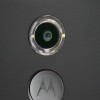Review: Motorola Moto X for Verizon Wireless
Screen
Motorola's Moto X matched its rivals as far as the display goes - almost. Last year's model had a 4.7-inch 720p screen and this year Motorola upped the display to 5.2 inches and 1080p resolution. In general, it looks good. I think it's sharp and colorful, and it offers excellent pixel density. The display manages to avoid gross fingerprint grime, but it isn't very bright. In fact, it is difficult to use outdoors, whether you're checking your email or hoping to take a picture. It's simply not bright enough to be seen under strong light. Viewing angles are decent, but not the best. There's a bit of brightness drop off *and* color shift (towards blue) when the phone is tilted side-to-side. This is probably because Motorola used PenTile technology in the display, which treats sub-pixels differently. Honestly, I thought the industry had moved away from PenTile displays and I'm disappointed to find one here. That said, the display should be fine for most people, but I've seen much better.
Signal
The Verizon version of the Moto X performed very well on Big Red's network. The phone easily found Verizon's LTE signal and remained connected throughout my review period. I was able to surf the web and make calls throughout the city of Las Vegas (even deep inside the casinos), as well as around northern NJ without issue. It did well in historically weak coverage areas, and never once dropped a call. Data speeds were best in strong coverage regions, but still good under the worst conditions. Motorola still knows how to make good wireless devices.
Sound
The quality of phone calls was good, bordering on great. For the most part, those with whom I spoke through the Moto X sounded clear and present, as though they were in the same room with me. Volume was good, but could have been a little bit better. I was able to hear calls in most environments, but the ding-ding-ding of casinos sometimes overpowered the earpiece. The speakerphone is louder, but somewhat more robotic sounding. I easily heard calls in a taxi or my house, though I wasn't as pleased with the quality. People I spoke to said I sounded very good through the Moto X. Ringtones and alerts were respectably loud, and the vibrate alert had no trouble catching my attention.
Battery
Motorola upped most specs of the 2014 Moto X - except for the battery. Last year's phone had a 2,200 power source, while this year's grows to only 2,300mAh. To put that into a little perspective, the HTC One (M8) has a 2,600mAh battery, the Galaxy S5 has a 2,800mAh battery, and the LG G3 has a 3,000mAh battery. All four devices use the same processor (Qualcomm Snapdragon 801) and have similar displays (5.x inches, 1080p HD). That said, the 2014 Moto X easily outlasts its predecessor. The original Moto X struggled to make it through a single day. This year's phone performs much better. I didn't have trouble using the phone for an entire 16- or 17-hour day (8AM to Midnight). In general, the phone still had some reserve power left when I went to bed (15% - 25%) despite solid use. The Moto X isn't a battery champ (some phones do better), but it isn't a battery chump, either.
Unlike competing models, the Moto X doesn't include a special battery-saver mode. You have to manage it all on your own.


 Hands On with the New Moto X
Hands On with the New Moto X
 Motorola Turns Moto X Into True Flagship
Motorola Turns Moto X Into True Flagship
 Motorola Moto X (CDMA, 2nd gen.)
Motorola Moto X (CDMA, 2nd gen.)










